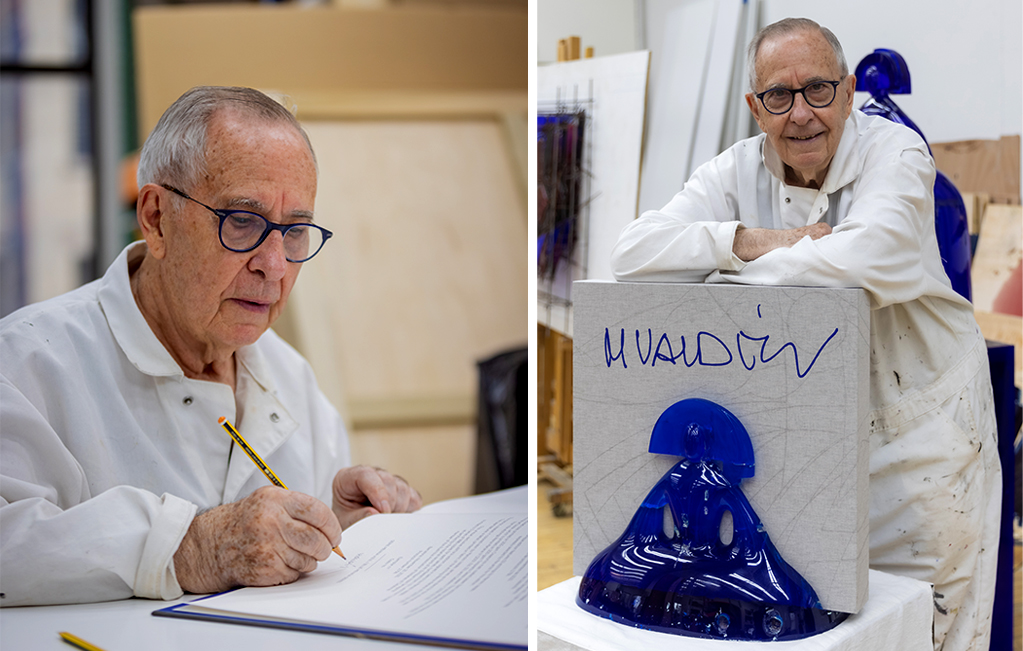From Velázquez to contemporary art: the work that best defines Manolo Valdés
Manolo Valdés has explored every language in the history of art. Painter, sculptor, and printmaker, his dialogue with the great masters is exemplified by his monumental meninas. One of these figures has been created for ARTIKA in a limited edition.
From the Golden Age to pop art
One of the most outstanding features of Manolo Valdés’s art is his dialogue with the legacy of Matisse, Picasso, and Warhol, among others. However, one of the painters who has most influenced his style was born at the end of the 16th century.

Left: Portrait of Greta Prozor, Henri Matisse. 1916. Oil on canvas. 146 x 96 cm. Center Georges Pompidou, Paris, France. ©Wikiart.
Right: Lillie IV, Manolo Valdés. 2007. Ed. 50. Etching and collage. 53 x 38 cm. ©Manolo Valdés.
The connection between Manolo Valdés and Diego Velázquez has been maintained for decades. Since his beginnings with the Equipo Crónica, the Valencian artist has been inspired by the iconic figures of the creator of Las Meninas (1656) to develop new interpretations. The result is a gallery of timeless works with an unmistakable identity.
Valdés was the first artist to create a sculptural personality for Velázquez’s characters, especially his queens, infants, and meninas. These are the most recognizable pieces of his career.
Material and volume: beyond the canvas
The Prado Museum has been one of his great sources of inspiration. There he discovered the works of Velázquez, especially the characters that, turned into monumental statues, now travel the world.
By studying the painting of the Golden Age genius, Manolo Valdés began to reflect: what if the protagonists of Las Meninas had three dimensions? What would, for example, the Infanta Margarita look like if we could see her from another perspective?
The idea of creating sculptural versions of Velázquez’s characters made it possible for an icon of art history to go beyond the limits imposed by the two dimensions of painting.

Left: Detail of Las Meninas by Velázquez. 1656. Oil on canvas. 320,3 x 279,1 cm. Prado Museum, Madrid, Spain.
Right: Image of the Menina from the work ‘Damas y Caballeros: Manolo Valdés’.
“Velázquez is in my DNA”
In his latest sculpted meninas, Manolo Valdés integrates diverse materials: wood, bronze, aluminum, marble, stone, glass, or resin. This achieves a powerful visual impact, especially thanks to the pigments he incorporates into his language. This color palette includes the blue of the sea, the color of the Mediterranean of his native Valencia.
These emblematic sculptures have been present in spaces around the world: in the New York Botanical Garden (the city where he resides), in Place Vendôme in Paris, and in the center of Singapore.
They have also traveled the streets of Valencia, Valladolid, Seville, or Madrid. Until June 15, 2024, thirteen two-meter-tall bronze meninas are on display in St. Mark’s Square in Venice. Now one of these pieces exclusively guards a very special artist’s book.

The Meninas by Manolo Valdés in St. Mark’s Square, Venice, 2024. @Galería de arte Contini.
A menina at ARTIKA
Damas y Caballeros: Manolo Valdés offers a panoramic view of Valdés’s art by combining sculpture, printmaking, and collage. This limited edition of 998 copies, all signed by the author, consists of an Art Book and a Study Book.
The first volume includes 53 prints from various series and periods selected by Valdés himself. In the second, leading experts analyze the artist’s creative vision and place each work in context.
The figure that holds both books is a menina designed exclusively by Valdés for this edition. This 15-kilogram sculpture-case is made of resin and incorporates pigments chosen by the artist.
Each copy is unique, as these meninas incorporate a feature sought by Valdés himself. These are the «noises», which are material imperfections (for example, bubbles and cracks). These random modifications provide uniqueness and make each Menina an unrepeatable piece.

An exclusive gem
Valdés’s work, rich in references and always in motion, has the language of the great creators: he is the most international active Spanish artist.
In the words of Guillermo Solana, Artistic Director of the Thyssen-Bornemisza National Museum and collaborator on the Study Book: “Manolo Valdés’s work contains all of art history, from a Sumerian head to a Lichtenstein bather, but Valdés’s vision belongs only to our time”.
Damas y Caballeros: Manolo Valdés is the artist’s most personal edition: a great opportunity for experts, collectors, and art lovers.

